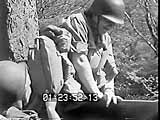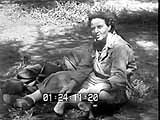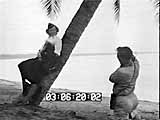|
The glamour appearance of nurses is the theme of one entire newsreel clip titled "Navy Nurses Look Good to the Boys of Guadalcanal." In the clip, nurses walk down a long runway from the ship and a cameraman stands near the bottom as they approach. The camera shifts noticeably to look up the skirts of the debarking nurses. After a voice-over comment concerning their nursing abilities, the narrator playfully says the "nurse can pose for a soldier as a pin-up girl!" and she obliges, leaning against a tree to show off her curvaceous figure for a man who photographs her (see Fox Movietonenews, "Navy Nurses Look Good to the Boys on Guadalcanal," May 1944, 51-775 V. 26/72).
In a sense this scene reinforces the gender roles John Berger has defined: women appear and men act (Berger, 47). Women are supposed to be feminine, men masculine. When there is a crossing of those highly guarded gender definition, there is confusion. To ensure the boundaries remain in place, activities which both feminize and masculinize the appropriate sexes are performed, replacing doubts of women becoming too masculine and men too feminine before a female presence (Butler, 133).
Interestingly enough, many scenes were filmed and later ignored in the assembling of footage to be seen by the public. In these outtakes, masculine women carry heavy objects, dig trenches, take part in gas attack training, assist men in setting up camps and eat, using closed lid toilets as makeshift tables (see Fox Movietonenews, "Women Soldiers on Italian War Front," January 20, 1944, 51-253A). In another interesting clip, the women are involved in an extensive training session. After what appears to be hours of hiking, the women fall to the ground underneath a shade tree and remove their shoes and socks. The barefoot women lie on their backs and smoke, taking long drags off their cigarettes, allowing their arms to fall lazily to the ground.

This nurse struggles over a fence during a training exercise. |

Another nurse takes a breather and attends to her blisters.
|
What is common in these clips is that they do not necessarily fulfill the appeals I discussed earlier. The scenes suggest that women will not always be in the sight and protection of men, they will likely experience unpleasantness they are not accustomed to, and finally they will take on masculine characteristics. In a time when there is both a concern about the masculinization of women and women becoming too permanent in any traditional male sector, it is not surprising the choice was made to cut these representations for others which were deemed more "appropriate."
War time nursing offered opportunities that were not experienced prior to the war, which was not at all brought out in the newsreels. Nurses were afforded a greater degree of independence and respect for their work than ever before. Their work was expanded far beyond bedpan duty and sheet changing to administration of medication, simple medical procedures, and diagnosing of symptoms and the degree of severity of wounds. And, while it may be true that the representations of the nurses did attract nurses to the war effort, a great disservice was done to the profession of nursing. Without powerful images of nurses in critical life and death situations, working long hours, and sacrificing like male soldiers of war, the newsreels suggested nurses are lesser soldiers at best and insignificant at worst.
page 2 of 2

Go to sources.
Jeri Kurtzleben is a graduate student at the University of Northern Iowa.
|







